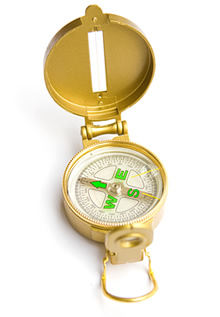In the modern era of the GPS and other electronic navigation devices, the use of a good old fashioned compass has become something of a lost art. Though it has been used for centuries by sailors, outdoorsmen, and the military, the technique has fallen by the wayside thanks to the Information Age. But what do you do when the batteries run out, or your favorite navigation device is rendered useless by forces of nature? This, of course, is where the old standard of navigation proves most useful. Whether your technology doesn’t work or you’d like to try adventuring the old fashioned way, you can use the following compass method to navigate effectively.
The First Step: Learning Your Compass
 There are three main parts of the compass that you need to know in order to use one for basic orienteering. The first is the red half of the needle, known as the compass needle. This is the key information bearing piece of the device. It always points toward Earth’s magnetic north pole. The second part is the compass housing. It is a circular, adjustable structure with degree marks included. You’ll use these to help determine the exact direction in which you want to travel. The final part of the compass you need to know is called the direction arrow. It’s usually painted on the outside of standard compasses, and will serve as the arrow you follow when actually making headway.
There are three main parts of the compass that you need to know in order to use one for basic orienteering. The first is the red half of the needle, known as the compass needle. This is the key information bearing piece of the device. It always points toward Earth’s magnetic north pole. The second part is the compass housing. It is a circular, adjustable structure with degree marks included. You’ll use these to help determine the exact direction in which you want to travel. The final part of the compass you need to know is called the direction arrow. It’s usually painted on the outside of standard compasses, and will serve as the arrow you follow when actually making headway.
Using Your Compass to Determine Direction
The important thing to remember here is that the red half of the compass needle always points north. So, to get started traveling in a particular direction, you must align the compass housing’s “N” (North) indicator with the red part of the needle and the compass’ direction arrow. Now that you’ve gotten your bearings, as they’re called, you can guide yourself in the direction you want to travel. Simply move the compass housing in a counterclockwise direction to the degree level you want to go on the directional arrow. Remember, 90 degrees from North is East, 180 is South, and 270 is West. If, say, you want to head south, turn the compass housing so that the 180 lines up with the directional arrow (without moving the body of the compass itself). At this point, the red arrow, 180 degree mark, and directional arrow should be lined up. Finally, turn the entire compass so that the red needle lines up again with the “N” section of the compass housing. If you’ve done it correctly, the directional arrow on your compass will now be pointing due South, and you’re ready to head in that direction!
Orienteering with a compass can be delved into with much more detail. In fact, there are entire volumes of literature focused solely on navigation with a compass. But even knowing how to do something as simple as finding direction with one is an incredibly useful skill, no matter what other navigational aids may exist.


Oh, wow! Thanks for sharing this one. I really suck at looking at compasses that I’ve always been a pain during hikes. But thanks to your post, I can start reminding myself to learn to read the compass again.